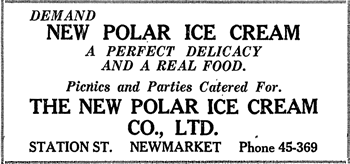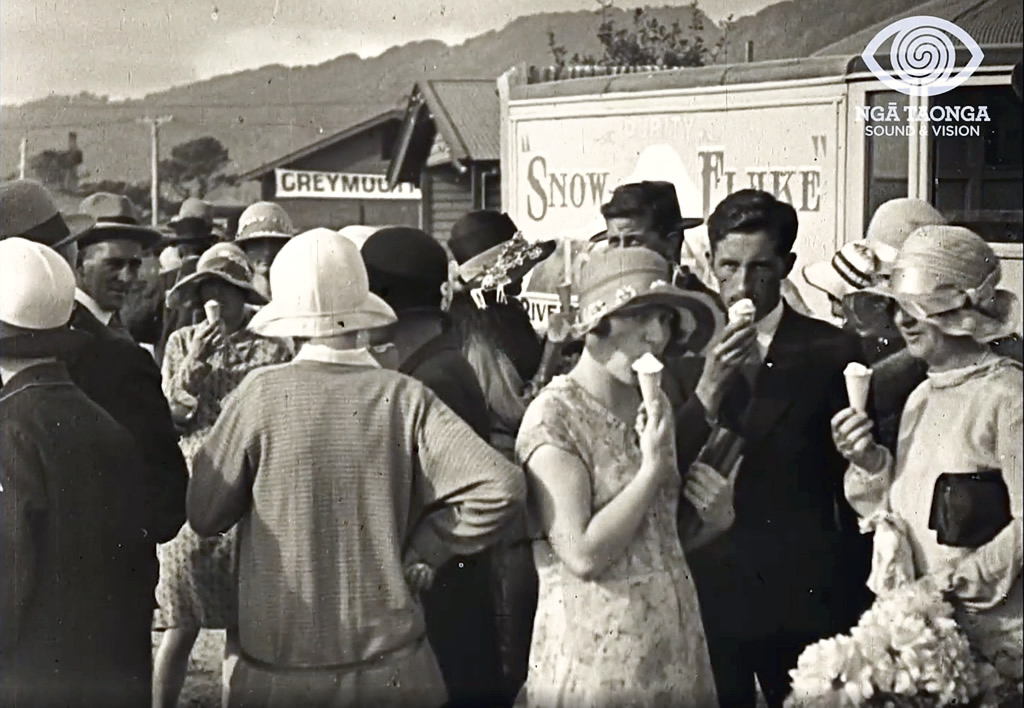|
Ice Cream Manufacturers Join Forces
As the ice cream industry grew, small regional manufacturers, many family-operated,
faced many problems in dealing with distribution, the dairy industry,
changing technology, hygiene standards, and outdated, archaic legislation:
12 February 1927 - the Christchurch Evening
Post reported that a number of manufacturers of ice cream
were charged with having sold their product on Sundays. In
his judgment the Magistrate said that he "was not prepared
to hold that the manufacture of ice cream was a necessity."
Ice cream was not even allowed to be sold from a cart on a Sunday. In
one 1928 prosecution, the judge said:
"Apparently it would be lawful for [the defendant] to
sell ice creams on a Sunday if he put up an awning from his cart,
and they were eaten under the awning."
The decision was made to form a national association, to help each other,
and to present a united voice to the government.
The New Zealand Ice Cream Manufacturers Association was
incorporated in 1927.
The inaugural meeting to discuss setting up an association was held on 22
July 1927 at the Frozen Products (Frosty Jack) offices in Wellington.
First members at that first meeting were W.A. (Arthur) Fisher, Frozen
Products, Wellington (instigator of the meeting, and generally
regarded as the founder of the NZICA); P.H. Ferguson, Robinson
Ice Cream Co., Auckland; and H. Turner, Crystal
Ice Cream, Dunedin.
Proposed qualification for membership: to be manufacturers of a certified
output of not less than 5,000 gallons per annum. Proposed subscription: £5:5:0
per annum.

First Chairman and President, Mr H. Turner
A constitution was soon written and the Association met for the first
time as an incorporated society in March 1928, at which
time it had eight members. At that meeting, the first President, Mr
H. Turner of Crystal Ice Cream in Dunedin, "stressed the
need for cooperation amongst manufacturers with a view to mutual assistance
and support in dealing with important regulations and legislation."

1929 - Within a year the Association had its first
success. The Executive persuaded the Railways Department to reduce the
excessive goods rate charged for rail freighting ice cream and to allow
cones to be dispatched in a single consignment with the ice cream, instead
of being consigned and charged separately.
The cost savings were early proof of the Association's value in representing
manufacturers collectively on matters that affected the whole industry.
A Profusion of Shapes and Flavours
In February 1929 the Ellesmere Guardian reported on a new innovation
- fruit ice cream.
Upon making inquiries he was
informed that Messrs W. R. Cooke and Son., Ltd., had closely studied
the methods adopted in America in connexion with ice cream and
how to manufacture the latest novelties. As a result arrangements
are now completed for serving all the leading American ice cream
dishes in Christchurch.
This fruit ice cream, although quite new to New Zealand,
is something that is good enough and should become
very popular. Of course, no
credit for originality can be claimed here, this form of ice cream
now being all the rage in America, "the land of ice cream."
The introduction of this novelty to Christchurch involved
the necessity for installing special plant to mix the
fruit evenly throughout the
cream. The machine recently installed is the latest American pattern,
costing £700, and brings the total value of the modern ice
cream plant operated by this firm in Christchurch to nearly £20,000.
Every reason exists for optimism in the immediate success of this
innovation. It may not be amiss to add that Cooke's were the people
chosen in Christchurch to supply the American Fleet while in Lyttelton
with their ''national dessert'' - ice cream. All the American novelties
will be produced from this new plant, and as proposed a new one will
be served each week at both 'The Tudor' Tea Rooms and 'Cooke's Ice
Cream Parlours' in High Street.
Patrons will be pleased to know it has been decided there will be
no increase in price over ordinary ice cream. |

New Polar Ice Cream advertisement, Auckland Star, 12 December 1929
12 July 1930 - The Auckland Star reported
on New Polar Ice Cream's stand at the Winter Show,
where they were selling "Rainbow Blocks, Polar Bars (a chocolate-coated
ice cream), Ice Cream Cakes and cartons of ices":
Briefly stated, it may be said
that the realm of artistic cakes has been invaded. Panelled and
decorated with pure frozen cream, the New Polar pure products include
ice cream wedding and birthday cakes, exact replicas of the baker's
art, but more suitable for the Auckland climate. And the flavour
is as good as the looks. They may be obtained in one, two or three
tiers, with the appropriate greetings and decorations for the required
occasion, whilst any flavouring required can be supplied on request.
Social events without the New Polar cakes will soon become quite
old-fashioned.
Rainbow Blocks: The novelties mentioned, however, do not exhaust
the list of New Polar originalities. Take the new Rainbow Block,
for instance, which when known will become absolutely de rigeur.
Fashioned after rainbow cake, the ice is served between the best
quality wafers. Three flavours are contained in it - vanilla, orange
and strawberry. The success of this novelty has been amazing. Well
over two thousand blocks have been sold at the Show, and repeat orders
are keeping the staff busy with a vengeance. |
23 December 1930 - An item in the Auckland Star describes
a new ice cream factory under construction in Pukeiti Road, Otahuhu,
for the Arctic Ice Cream Company:
The spacious, strongly cork-insulated
hardening room, which will have a temperature 10 degrees below
zero, has a capacity of up to 800 gallons, so that it will meet
the largest emergency demands, and the mistakes of other firms
will not be repeated.
Nearby in a separate compartment are the brine tank and the freezing
churn.
The "Lindee" compressor, large ice-making tank, packing
store and other facilities emphasise that the Arctic
Ice Cream Company will
be able to cope with orders on a scale not previously attempted.
The building alterations were carried out by Mr. T. Clements, of
Otahuhu, and the new refrigerating plant has been supplied by Messrs.
Wildridge and Sinclair, Ltd.
The "Arctic" firm, whose new refrigerated van has been
a striking trade vehicle in Auckland recently, is already
placing a number of
ice cream novelties before the public. However, one of its exclusive
lines sure to enjoy distinction, is the "Popsicle",
a frozen sweet in selected fruit flavours, wrapped in vegetable
parchment paper, attached to a stick. This is a wonderful cooler
and thirst
quencher and will be extremely popular at beaches, carnivals and
other gatherings during the summer.
The Arctic Company, which has the sole manufacturing
rights for New Zealand for the "Popsicle," is able
to supply also, a range of delicious ice cream cakes
suitable for birthday celebrations and social meetings. |

People enjoying Snowflake icecream in front of the Snowflake Riverdale
Dairy Supplies Guy truck, at the 1930 Greymouth A&P Show.
Still from newsreel film, "The Greymouth Gazette", by L. Inkster,
1930.
- Nga
Taonga Sound & Vision.
 1931
- 1940 1931
- 1940
 1911
- 1920 1911
- 1920
Sources, references and related sites:
Archives New Zealand:
http://archives.govt.nz/
Auckland Libraries
Hamilton City Libraries - Hamilton Heritage
http://hamiltonheritagecollections.co.nz/
National Library
NZ Ice Cream Assn. archives, and "Frostee Digest" journals, 1943-1972.
New Zealand Ice Cream Manufacturers' Association (NZICA) Oral History Project;
held at NZICA archives and Alexander Turnbull Library.
- Shona McCahon, Oral historian.
Nga Taonga Sound & Vision
Owen Norton personal collection.
Papers Past (National Library of New Zealand digitised newspapers database):
http://paperspast.natlib.govt.nz/
Queen Anne:
www.queenanne.co.nz
Salvage Place
www.salvageplace.nz
Robyn O'Leary - personal correspondence.
 Back to
The History of Ice Cream in New Zealand Back to
The History of Ice Cream in New Zealand |